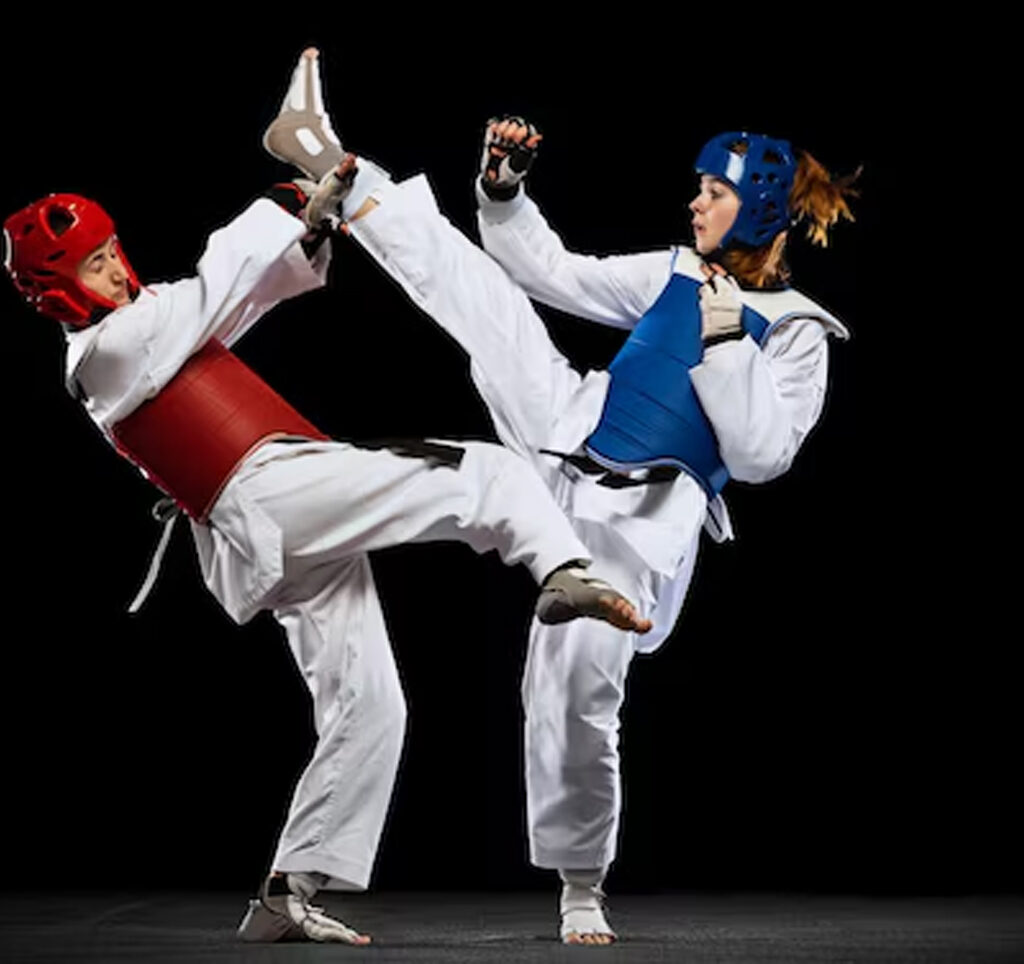Taekwondo Sparring (“kyorugi”)

Taekwondo sparring, often called “kyorugi” in Korean, is a dynamic and competitive aspect of Taekwondo training in which practitioners engage in controlled, full-contact combat using rules and regulations. It is a fundamental component of Taekwondo training, allowing practitioners to apply the techniques they’ve learned in a dynamic and realistic setting while emphasizing speed, technique, strategy, and control.
Here’s a detailed breakdown of Taekwondo sparring:
- Objective: The primary aim of Taekwondo sparring is to score points by delivering accurate and powerful kicks or punches to specific areas of the opponent’s body while avoiding being struck. Each successful strike earns points, and the competitor with the most points at the end of the match wins.
- Equipment: Competitors wear protective gear to minimise the risk of injury. This typically includes a helmet, chest protector, forearm guards, shin guards, groin guards (for males), and mouthguards. The gear varies depending on the level of competition and the rules set by the governing body.
- Rules and Regulations: Taekwondo sparring follows a strict set of rules and regulations established by various governing bodies, such as the World Taekwondo (WT). These rules govern aspects such as permissible techniques, scoring criteria, round duration, penalties for rule violations, and safety protocols.
- Scoring: Points are awarded based on the accuracy and effectiveness of strikes. The scoring zones typically include the torso (front and back), head, and sometimes the sides of the body. Different techniques carry different point values, with more complex or powerful techniques often scoring higher.
- Techniques: Taekwondo sparring emphasises various kicking and punching techniques executed with speed, power, and precision. Standard methods include front kick (ap chagi), roundhouse kick (dollyo chagi), side kick (yeop chagi), back kick (dwit chagi), and turning kick (dollyo chagi), among others. Punches to the body and head are also allowed, though they are less common than kicks due to the nature of Taekwondo’s emphasis on kicking techniques.
- Strategy and Tactics: Sparring is not just about physical skill but also about strategic thinking. Competitors must assess their opponent’s strengths and weaknesses, adapt their tactics accordingly, and employ offensive and defensive techniques to outmanoeuvre and outscore their opponent. This strategic sparring aspect adds an engaging and intellectually stimulating dimension to the sport.
- Control: While Taekwondo sparring involves full-contact combat, competitors must exercise control over their techniques to avoid causing unnecessary harm to their opponent. This emphasis on control ensures the participants’ safety and promotes a culture of respect and responsibility in the sport. Excessive force or reckless behaviour can result in penalties or disqualification, reinforcing the importance of control in Taekwondo sparring.
Overall, Taekwondo sparring is not just a training component but a dynamic and challenging aspect that keeps practitioners excited and motivated. It promotes physical fitness, mental discipline, and strategic thinking while fostering camaraderie and sportsmanship among practitioners.
